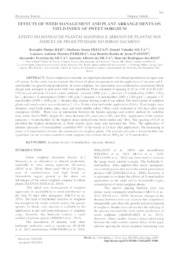Effects of weed management and plant arrangements on yield index of sweet sorghum.
Effects of weed management and plant arrangements on yield index of sweet sorghum.
Autoria: REIS, R. M.; FREITAS, M. S.; SILVA, D. V.; PEREIRA, G. A. M.; PASSOS, A. B. R. de J.; SILVA, A. F. da; SILVA, A. A. da; REIS, M. R. dos
Resumo: Sweet sorghum is currently an important alternative for ethanol production in sugar cane off-season. In this study was to evaluate the effects of plant arrangements and the application of atrazine and Smetolachlor on growth and productivity of sweet sorghum. An experiment was conducted in randomized block design and, arranged in split plots with four repetitions. Plots consisted of spacing (0.25 m, 0.45 m 0.45-0.450.90 m) and sub-plots of weed control methods - atrazine (2000 g ha-1), atrazine + S-metolachlor (2000 + 720 g ha-1), atrazine + S-metolachlor (2000 + 960 g ha-1), atrazine + S-metolachlor (2000 + 1200 g ha-1), atrazine + Smetolachlor (2000 + 1440 g ha-1). Besides that, manual hoeing control was added. The intoxication of sorghum plants and weed control was evaluated at 7, 14 e 28 days after herbicides application (DAA). Plant height, stem diameter, total fresh matter, juice mass and total soluble solids (°Brix) were evaluated at 120 days after crop emergence (DAE). There was no interaction between the factors spacings and control method for variables total matter fresh (TMF), height (H), stem diameter (D), juice mass (JM), and Brix. Application of the mixture (atrazine + S-metolachlor) in the highest doses reduced total fresh matter and °Brix. The spacing of 0.25 m provided the highest productivity of fresh matter, juice mass and increased the °Brix. The application of mixture (atrazine + S-metolachlor) controlled 90% of the weeds at 28 days after application. The increasing in doses of S-metolachlor elevates the intoxication in sorghum plants. The mixture (atrazine + S-metolachlor) has a potential for use in weed control in sweet sorghum, but at doses below 960 g ha-1 of S-metolachlor.
Ano de publicação: 2019
Tipo de publicação: Artigo de periódico
Unidade: Embrapa Milho e Sorgo
Palavras-chave: Atrazina, Biocombustível, Erva Daninha, Planta daninha, Produtividade, Sorghum Bicolor
Observações
1 - Por padrão são exibidas publicações dos últimos 20 anos. Para encontrar publicações mais antigas, configure o filtro ano de publicação, colocando o ano a partir do qual você deseja encontrar publicações. O filtro está na coluna da esquerda na busca acima.
2 - Para ler algumas publicações da Embrapa (apenas as que estão em formato ePub), é necessário ter, no celular ou computador, um desses softwares gratuitos. Sistemas Android: Google Play Livros; IOS: iBooks; Windows e Linux: software Calibre.
Acesse outras publicações
Acesse a Base de Dados da Pesquisa Agropecuária (BDPA) para consultar o acervo completo das bibliotecas da Embrapa.

